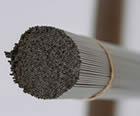History of stainless steel
The material we know as stainless steel (also commonly referred to as "Inox" or "Rostfrei") is such a common feature of 21st century living that there can be few of us who have not seen or handled articles made from it. But how many of us really know what stainless steel is?What is stainless steel?
'Stainless' is a term coined early in the development of these steels for cutlery applications. It was adopted as a generic name for these steels and now covers a wide range of steel types and grades for corrosion or oxidation resistant applications.Stainless steels are iron alloys with a minimum of 10.5% chromium. Other alloying elements are added to enhance their structure and properties such as formability, strength and cryogenic toughness.
- Nickel
- Molybdenum
- Titanium
- Copper
- Carbon
- Nitrogen
the main requirement for stainless steels is that they should be corrosion resistant for a specified application or environment. The selection of a particular "type" and "grade" of stainless steel must initially meet the corrosion resistance requirements. Additional mechanical or physical properties may also need to be considered to achieve the overall service performance requirements.
The History of Stainless Steel
A few corrosion-resistant iron artifacts survive from antiquity. A famous (and very large) example is the Iron Pillar of Delhi, erected by order of Kumara Gupta I around the year AD 400. However, unlike stainless steel, these artifacts owe their durability not to chromium, but to their high phosphorus content, which together with favorable local weather conditions promotes the formation of a solid protective passivation layer of iron oxides and phosphates, rather than the non-protective, cracked rust layer that develops on most ironwork.
Hans Goldschmidt
This situation changed in the late 1890s, when Hans Goldschmidt of Germany developed an aluminothermic (thermite) process for producing carbon-free chromium. In the years 19041911, several researchers, particularly Leon Guillet of France, prepared alloys that would today be considered stainless steel. In 1911, Philip Monnartz of Germany reported on the relationship between the chromium content and corrosion resistance of these alloys.
Harry Brearley of the Brown-Firth research laboratory in Sheffield, England is most commonly credited as the "inventor" of stainless

Harry Brearley
Related products |
|
<
>
|





